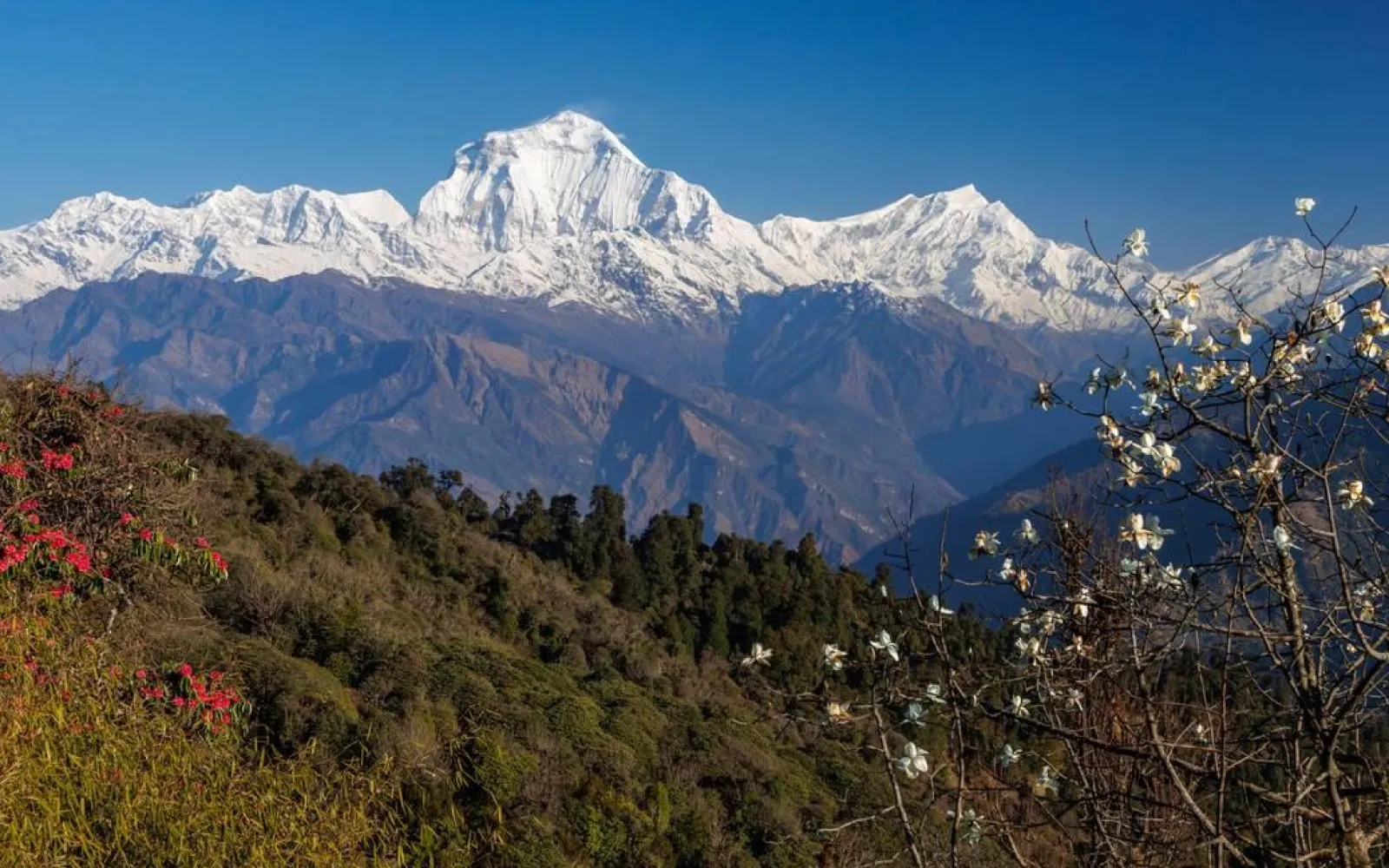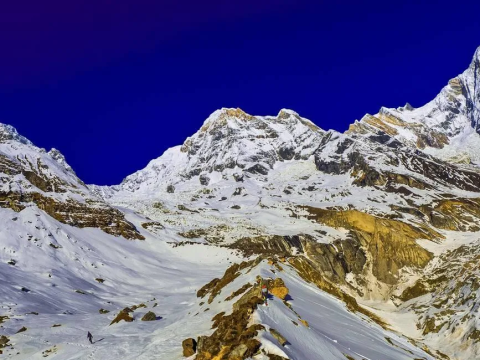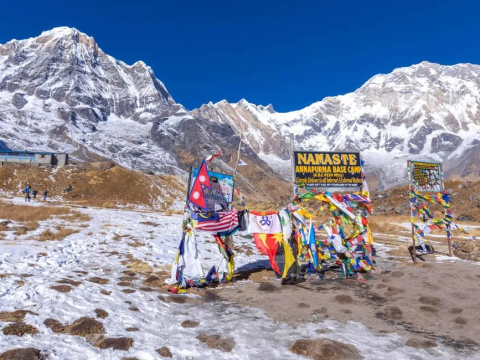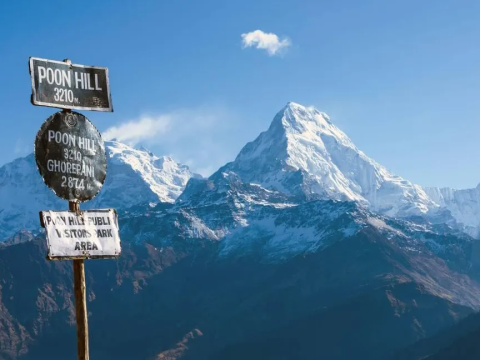Explore on one of Nepal's most scenic and diverse trekking adventures—the Annapurna Poon Hill to Mardi Himal Trek—a perfect blend of cultural immersion, Himalayan panoramas, and authentic mountain experiences. Offered by Asiana Treks and Tours, this 12-day journey takes you through lush forests, traditional Gurung and Magar villages, rhododendron-filled trails, and into the heart of the Annapurna region. The route beautifully combines two of the region’s iconic trekking trails—Poon Hill, known for its spectacular sunrise views, and Mardi Himal, a hidden gem that leads to a dramatic base camp just beneath the majestic Mardi Himal (5,587 m) and Machhapuchhre (Fishtail) Peak.
This trek is designed for adventurers who want a moderately challenging route with unmatched visual rewards. It begins in Kathmandu, travels through the serene lakeside city of Pokhara, and delves deep into the Himalayan foothills, offering daily treks between 5 to 10 hours. Each day brings a new experience—whether it's climbing the famed stone steps of Ulleri, watching the sun rise over Dhaulagiri and Annapurna from Poon Hill, or reaching the remote highlands of Mardi Himal Base Camp.
This curated itinerary by Asiana Treks and Tours is ideal for both first-timers and seasoned hikers who want to witness the diverse beauty of the Annapurna region without the long duration of Annapurna Circuit or Annapurna Base Camp treks.
Highlights:
- Combines two famous treks: Poon Hill & Mardi Himal
- Incredible sunrise over Annapurna and Dhaulagiri from Poon Hill
- Dense rhododendron and oak forests to alpine ridges
- Mardi Himal Base Camp at 4,500 meters
- Authentic cultural interaction in Gurung and Magar villages
- Fully guided and supported by expert local guides
Why Trekking the Annapurna Region Should Be on Your Bucket List
The Annapurna region is one of the most iconic and accessible trekking destinations in the world. With stunning vistas of 8,000-meter peaks, diverse ecosystems, and a warm, welcoming local culture, this region offers something for everyone. Trekking with Asiana Treks and Tours, you will be immersed in a world of breathtaking natural beauty and cultural richness that leaves a lasting impression. From forested trails to glacial valleys, every step brings you closer to the spirit of the Himalayas.
One of the greatest advantages of trekking in Annapurna is its well-managed trail network and teahouse infrastructure. Whether you're marveling at the symmetrical Machhapuchhre (Fishtail) or enjoying fresh Dal Bhat with local families, you'll be well taken care of throughout your journey. Moreover, the combination of moderate elevations, high-quality lodging, and a wide variety of routes makes it ideal for trekkers of all skill levels.
Reasons to Add Annapurna to Your Travel List:
- Home to 3 of the world’s 10 highest peaks: Annapurna I, Dhaulagiri, and Manaslu
- Diverse landscapes—from rice paddies to alpine meadows
- Cultural richness with Buddhist and Hindu influences
- Safe, well-established trails with ample facilities
- Shorter yet rewarding treks like Poon Hill and Mardi Himal
- Ideal for solo, group, and family treks
Annapurna for Beginners: What Makes Poon Hill and Mardi Himal Special
For trekkers new to the Himalayas, the Poon Hill and Mardi Himal combination trek offers a perfect introduction. At Asiana Treks and Tours, we believe this route balances comfort, challenge, and scenery in a way that’s ideal for first-time trekkers or those with limited time. The trek begins with a gentle ascent through forests and charming villages, gradually leading you to panoramic viewpoints that rival more strenuous treks. Poon Hill, at 3,210 meters, is famed for its sweeping sunrise views across the Annapurna and Dhaulagiri ranges—ideal for beginner trekkers seeking big rewards with moderate effort.
The Mardi Himal section, while slightly more challenging, adds a touch of adventure and wilderness to your journey. After reaching the serene village of Landruk, the trail ascends through moss-covered forests to Low and High Camps, eventually reaching Mardi Himal Base Camp at 4,500 meters. This area is far less crowded than other treks, allowing beginners to experience raw Himalayan nature without the hustle and bustle. Plus, with the expert guidance from our local team, your journey will be safe, informative, and incredibly rewarding.
Why It’s Great for Beginners:
- Moderate altitude and manageable trekking distances
- Stunning vistas without extreme elevation gain
- Easy access from Pokhara with short drives to trailheads
- Comfortable teahouses and delicious local food along the way
- Ideal acclimatization profile for first-timers
Planning the Perfect Trek: Poon Hill to Mardi Himal Route Overview
Planning a trek from Poon Hill to Mardi Himal is about more than just hiking—it's about curating a Himalayan experience that blends nature, culture, and adventure. With Asiana Treks and Tours, your journey begins in the historic city of Kathmandu, continues to the scenic lakeside haven of Pokhara, and moves into the heart of the Annapurna Conservation Area. This 12-day trek follows a carefully designed path that includes iconic locations like Ulleri, Ghorepani, Tadapani, and Landruk, before rising to the alpine ridge leading to Mardi Himal Base Camp at 4,500 meters.
Unlike more strenuous and crowded treks like Annapurna Base Camp or Everest Base Camp, this route offers both high-impact views and a sense of tranquility. Starting with the famed Poon Hill sunrise, the trail gradually increases in altitude and remoteness as you reach the less-explored Mardi Himal region. It’s perfect for trekkers who want a taste of both popular and off-the-beaten-path trails. The combination also allows for excellent acclimatization, enhancing safety and enjoyment.
Route Overview Highlights:
- Start Point: Kathmandu → Drive to Pokhara
- Key Villages: Ulleri, Ghorepani, Tadapani, Landruk
- Highest Point: Mardi Himal Base Camp (4,500 m)
- Total Duration: 12 days (including arrival/departure)
- Trek Type: Teahouse-based, moderate difficulty
- Trek Style: Cultural, scenic, and off-beat mix
When to Go: Best Seasons for Poon Hill to Mardi Himal Trek
Timing is everything when it comes to trekking in Nepal, and the Poon Hill to Mardi Himal trek is no exception. The best times to embark on this scenic journey are during the spring (March to May) and autumn (September to November) seasons. During these months, the weather is clear, skies are blue, and mountain views are at their finest. Springtime brings blooming rhododendron forests, turning the hills into a vibrant canvas of red, pink, and white—especially between Ghorepani and Tadapani.
Autumn is equally magical, offering crisp air and clear visibility. The post-monsoon atmosphere makes for perfect panoramic photography and safer, drier trails. Temperatures are comfortable during the day and mildly cold at night, especially at higher altitudes like Mardi Himal Base Camp. While winter (December–February) offers solitude and stunning snow-covered landscapes, the cold can be harsh, especially above 3,000 meters. Summer/monsoon (June–August) is not recommended due to heavy rains, slippery trails, and leeches.
Best Season Summary:
- Spring (March–May): Best for wildflowers and mild temperatures
- Autumn (Sept–Nov): Clear skies, best visibility, and ideal trekking weather
- Winter (Dec–Feb): Fewer crowds, snow views, but colder nights
- Monsoon (June–Aug): Not recommended due to rain and landslides
- Ideal Timeframe: Late March to early May or late September to mid-November
Essential Gear for Poon Hill to Mardi Himal Trekking
Packing the right gear is crucial for a successful and enjoyable trek from Poon Hill to Mardi Himal. The journey covers varied terrain, altitudes, and weather conditions, so your packing list should reflect that. At Asiana Treks and Tours, we provide packing recommendations that strike a balance between comfort, weight, and preparedness. You’ll need everything from lightweight clothing for lower altitudes to warm insulation layers for nights at higher camps like High Camp (3,580 m) and Mardi Himal Base Camp (4,500 m).
Start with moisture-wicking base layers, followed by fleece or down jackets for warmth. A waterproof shell is essential in case of unexpected showers. Durable trekking boots, wool socks, and quick-drying pants will keep you comfortable on trail. Don’t forget sun protection—hat, sunglasses, and SPF—especially above 3,000 meters where the UV is stronger. A small daypack (30–40L) with hydration system, headlamp, reusable water bottles, trekking poles, and a good sleeping bag rated for -10°C are also must-haves. For electronics, bring power banks and maybe a solar charger, as charging can be costly at teahouses.
Essential Gear Checklist:
- Trekking boots (broken-in) & sandals for teahouses
- Thermal layers, fleece/down jacket, waterproof shell
- Hat, gloves, sunglasses, buff/scarf
- Backpack (30–40L) with rain cover
- Water purification tablets or filtration system
- Trekking poles & headlamp
- Sleeping bag (-10°C comfort rating)
- Toiletries, blister kit, first-aid, sunscreen
- Passport copy, permits (managed by Asiana Treks)
Fitness & Preparation: How to Get Trek-Ready for Annapurna
While the Poon Hill to Mardi Himal trek isn’t as extreme as Everest Base Camp, it still demands a decent level of physical fitness and endurance. The trail involves multiple days of hiking for 5–10 hours, steep stone staircases, and altitude gains up to 4,500 meters. At Asiana Treks and Tours, we recommend preparing at least 6–8 weeks in advance with a mix of cardio, strength, and flexibility training. Regular hill or stair climbing with a weighted backpack can simulate trekking conditions.
Equally important is mental preparation. Be ready for long walking days, basic teahouse accommodations, and unpredictable weather. Altitude can affect anyone, so pacing yourself and staying hydrated is essential. If possible, include a few practice hikes at moderate elevation to get used to the terrain. Also, breaking in your boots and testing your gear beforehand will ensure comfort and confidence on the trail.
We design our treks with built-in acclimatization and support. Our guides will monitor your health and comfort, and porters will carry the heavy load so you can focus on enjoying the trail. No prior trekking experience is required, but good physical shape makes the experience far more enjoyable.
Fitness Prep Tips:
- Start training 6–8 weeks before departure
- Focus on hiking, stair climbing, and cardio
- Strengthen legs, core, and back muscles
- Practice carrying a daypack (5–8 kg)
- Hydrate well, even during training
- Try at least one overnight hike before the trip
- Consult a doctor for altitude sickness prevention if needed
What to Expect on the Trail: Landscapes, Lodges, and Local Life
Trekking from Poon Hill to Mardi Himal is not just about walking trails—it's about immersing yourself in a living Himalayan landscape that constantly changes as you ascend and descend. At lower altitudes, expect to walk through lush terraced rice fields, dense subtropical forests, and colorful rhododendron groves. As the trail climbs, the environment shifts to moss-draped cloud forests, then to rugged alpine ridges with wide open views of the snow-capped Annapurna Massif, Dhaulagiri, and Machhapuchhre (Fishtail Peak).
Along the way, you’ll stay in cozy, family-run teahouses that offer basic but comfortable accommodations and hearty Nepali meals like dal bhat, momos, and Tibetan bread. These lodges are not just shelters—they're cultural experiences where you meet other trekkers, learn about local customs, and enjoy warm hospitality. The vibe is peaceful and simple, with nights often spent chatting by the fireplace or stargazing under clear mountain skies.
Equally enriching is the chance to interact with locals, mostly from Gurung and Magar communities. Whether you’re watching them harvest crops or participating in a village ceremony, you’ll gain insight into rural Himalayan life. The trail offers a raw, authentic connection to nature and culture, away from commercialized tourism.
Trail Expectations:
- Diverse terrain: rice terraces, rhododendron forests, alpine ridges
- Panoramic views of Annapurna, Dhaulagiri, Machhapuchhre
- Teahouse lodging with warm food and social atmosphere
- Friendly locals and cultural exchanges in villages
- Quiet trails (especially after Ghorepani) for reflection and peace
Cultural Highlights Along the Trek: Villages, Temples, and Traditions
One of the most enriching parts of the Poon Hill to Mardi Himal trek is the cultural exposure along the way. Trekking with Asiana Treks and Tours, you’ll pass through a number of traditional villages inhabited primarily by Gurung and Magar ethnic groups, known for their rich traditions, hospitality, and deep connection to the mountains. The village of Ghorepani, for example, is more than just a stop before sunrise at Poon Hill—it’s a cultural hub where traditional stone houses line narrow alleys and locals wear regional dress during special events.
Further along, the trek brings you to Tadapani, Landruk, and Forest Camp, where life moves to the rhythms of farming, animal herding, and seasonal festivals. You’ll see prayer flags fluttering in the breeze, small Buddhist chortens and mani walls, and in some places, Hindu temples tucked into hillsides. Most villages have small gompas (monasteries) or shrines that you’re welcome to visit respectfully. You may even encounter local festivals like Tihar or Maghe Sankranti, depending on your timing.
Interacting with locals gives you a real sense of Nepali mountain life—kids walking to school in uniforms, elders spinning prayer wheels, or women weaving baskets. These aren’t tourist performances; they’re real-life moments that make the journey unforgettable. With our experienced guides as cultural interpreters, you’ll leave with not just memories, but a deeper understanding of the region.
Cultural Highlights:
- Gurung & Magar heritage in Ghorepani, Landruk, Siding
- Buddhist chortens, prayer flags, temples along trail
- Traditional stone houses and rural life immersion
- Seasonal festivals and local rituals
- Chance to learn a few Nepali words and customs
A Trekker’s Journal: My Day-by-Day Experience from Poon Hill to Mardi Himal
Day 1–2: The journey begins in Kathmandu, with its chaotic charm and historic temples. A scenic drive takes us to Pokhara, the serene lakeside town that acts as our gateway to the Annapurnas.
Day 3: We drive to Birethanti and begin trekking to Ulleri. The stone steps are steep, but the views of the valley and distant snow peaks push me forward. Locals smile and say “Namaste” as we pass.
Day 4–5: Reaching Ghorepani, we rest and wake up early for the legendary Poon Hill sunrise. The golden light over Dhaulagiri and Annapurna leaves me speechless. Then we head to Tadapani, trekking through a fairytale forest of rhododendrons.
Day 6–7: The trail to Landruk is full of village scenes—children playing, farmers working, and endless green terraces. The next day we climb steadily to Low Camp. The forest grows denser and the air thinner.
Day 8–9: We hike to High Camp, now above the tree line. The views become wide and dramatic. The big day arrives: we trek to Mardi Himal Base Camp at 4,500 meters. It’s a long day—cold, windy, breathtaking in every way.
Day 10–11: Descending to Badal Danda, we savor our last alpine views before continuing to Siding and driving back to Pokhara. The final drive to Kathmandu is bittersweet—tired legs, full hearts.
Day 12: Departure day. I leave Nepal a little more humble, grounded, and grateful.
Journal Highlights:
- Poon Hill sunrise – a spiritual experience
- Forest trails feel like walking through a storybook
- Mardi Himal Base Camp – raw, powerful, emotional high point
- Memorable cultural moments in villages
- Trek balances challenge with peaceful reflection
Which One is Better, Mardi Himal or Poon Hill?
When it comes to choosing between Poon Hill and Mardi Himal, the answer depends on what kind of experience you’re looking for. At Asiana Treks and Tours, we often recommend combining both—as in our 12-day Poon Hill to Mardi Himal trek—because each route offers something unique. Poon Hill is perfect for those seeking breathtaking mountain views with minimal effort. It’s accessible, relatively short, and famous for the sunrise over Annapurna and Dhaulagiri that lights up the horizon in gold.
On the other hand, Mardi Himal is a more adventurous and off-the-beaten-path trek. It climbs higher, reaching up to 4,500 meters at Base Camp, and offers stunning close-up views of Machhapuchhre (Fishtail) and the Mardi Himal ridge. While it’s more physically demanding, it’s far less crowded, giving trekkers a greater sense of wilderness and solitude.
If you’re a beginner or short on time, Poon Hill might be better. If you’re looking for something a little more remote, with more elevation gain and raw alpine landscapes, Mardi Himal is the ideal choice.
Quick Comparison:
- Poon Hill: Easier, shorter, crowded, iconic sunrise views
- Mardi Himal: Higher altitude, fewer people, more adventure
- Best Option: Combine both for variety and full Annapurna experience
- Our Verdict: Mardi Himal offers more dramatic scenery, Poon Hill offers accessibility
Mardi Himal vs. Poon Hill: Highlights
Both Poon Hill and Mardi Himal are highlights in their own right, offering different but equally spectacular Himalayan experiences. With Asiana Treks and Tours, you get to explore both within a single itinerary—perfect for trekkers who want variety in both scenery and trail experience.
Poon Hill is renowned for its unforgettable sunrise panorama of the Annapurna and Dhaulagiri ranges. Reached via a scenic trail through Gurung and Magar villages and dense rhododendron forests, it’s the most photographed viewpoint in Nepal for a reason. The hike up to Poon Hill (3,210 meters) is relatively short and steep, making it accessible yet rewarding.
In contrast, Mardi Himal delivers a sense of remote adventure. Starting from Landruk and ascending through cloud forests to High Camp (3,580 meters) and finally to Mardi Himal Base Camp (4,500 meters), the trail feels wild and immersive. The views of Machhapuchhre (Fishtail) from Mardi are unmatched, and the high-altitude landscape is surreal.
Key Highlights Comparison:
- Poon Hill: Sunrise views, lush forests, cultural villages
- Mardi Himal: Closer to peaks, high-altitude wilderness, fewer trekkers
- Both Together: Provide forest, ridge, village, and alpine experiences in one trek
- Visual Highlights: Annapurna South, Dhaulagiri, Machhapuchhre up close
- Poon Hill for Photos, Mardi Himal for Immersion
Mardi Himal vs. Poon Hill: Starting and Ending Points
The starting and ending points of the Mardi Himal and Poon Hill treks differ both in terms of logistics and elevation. Poon Hill typically starts from Nayapul (or Birethanti), about 1.5 hours’ drive from Pokhara, and passes through villages like Ulleri, Ghorepani, and Tadapani. The endpoint is often Ghandruk or Landruk, offering scenic drives back to Pokhara. This makes it ideal for shorter trekking itineraries with easy access in and out.
In contrast, Mardi Himal usually begins in Landruk or Kande, depending on your chosen trailhead. Our custom route at Asiana Treks and Tours picks up from Landruk, climbing steadily to Low Camp, High Camp, and eventually Mardi Himal Base Camp. The descent continues through Badal Danda and down to Siding, where a jeep will take you back to Pokhara.
While both treks start and end near Pokhara, Mardi Himal's route brings you deeper into the mountains. It also requires better trail navigation, which is why trekking with experienced guides like ours is highly recommended.
Start/End Point Summary:
- Poon Hill Start: Nayapul (Birethanti)
- Poon Hill End: Ghandruk or Landruk
- Mardi Himal Start: Landruk or Kande
- Mardi Himal End: Siding (then drive to Pokhara)
- Logistics: Both are Pokhara-based, but Mardi is more remote
Which One is More Difficult, Mardi Himal or Poon Hill?
In terms of difficulty, the Mardi Himal trek is undeniably more challenging than Poon Hill. While Poon Hill tops out at just over 3,210 meters, Mardi Himal reaches 4,500 meters, and that extra altitude means thinner air, colder temperatures, and tougher climbs. The Mardi route also involves steeper ascents and descents over rugged terrain, especially between High Camp and Base Camp, where paths can be narrow and exposed.
Poon Hill, on the other hand, is more accessible and beginner-friendly. Though the Ulleri staircase can be physically demanding (especially the 3,000+ stone steps), the overall elevation and distance make it a moderate trek suitable even for first-timers. The trails are well-established, and villages are close together, providing more comfort and support along the way.
That said, neither trek requires technical climbing skills. With the right fitness level and preparation—along with Asiana Treks and Tours’ expert guides and porters—both treks are achievable and safe. If you're after a real adventure and don't mind a bit of effort, Mardi Himal is worth it.
Difficulty Comparison:
- Poon Hill: Moderate; good for beginners
- Mardi Himal: Moderate to challenging; higher altitude
- Toughest Part: Mardi Himal Base Camp climb (long day, altitude)
- Best for Beginners: Poon Hill
- Best for Adventurers: Mardi Himal
Which One is Longer, Mardi Himal or Poon Hill?
In terms of both distance and duration, Mardi Himal is generally longer than the Poon Hill trek. A standard Poon Hill trek takes about 4–5 days, while Mardi Himal typically spans 6–7 days, depending on the chosen route and pace. When combined, as in our 12-day itinerary, they create a balanced trek that gradually builds from cultural lowlands to dramatic high-altitude terrain.
Poon Hill is a more condensed experience—starting at a lower elevation and reaching its peak within two or three days. It's ideal for short itineraries or for those wanting a lighter trekking experience with big views. In contrast, Mardi Himal requires longer hiking hours and covers a greater altitude range, meaning more time is needed for acclimatization and slower ascents.
With Asiana Treks and Tours, we strategically combine both treks to maximize scenery and minimize altitude risk. The longer duration also allows for deeper cultural engagement and more variety in terrain—from rhododendron forests to alpine ridges.
Length Comparison:
- Poon Hill: 4–5 days, shorter distances
- Mardi Himal: 6–7 days, longer, more elevation
- Combined Trek: 12 days with gradual buildup
- Best for Short Trips: Poon Hill
- Best for Extended Exploration: Mardi Himal
Conclusion
The Poon Hill to Mardi Himal Trek is a journey that beautifully weaves together Nepal’s iconic landscapes, vibrant cultures, and soul-stirring mountain experiences. Designed by Asiana Treks and Tours, this carefully curated 12-day trek brings you the best of both worlds—Poon Hill’s legendary sunrise panoramas and Mardi Himal’s remote alpine ridges. What starts as a gentle cultural trek through Gurung and Magar villages gradually transforms into a dramatic high-altitude adventure, culminating at the breathtaking Mardi Himal Base Camp (4,500 meters) beneath the sacred Machhapuchhre (Fishtail Peak).
This trek offers something for every type of traveler. Beginners can ease into the rhythm of trekking with the well-paved paths of Ghorepani and Tadapani, while adventure-seekers will find the wild beauty of Mardi Himal’s upper reaches truly rewarding. Along the way, trekkers experience the warmth of local hospitality in traditional teahouses, traverse rhododendron forests bursting with color, and walk along ridgelines that offer uninterrupted views of some of the world’s highest peaks. And perhaps most importantly, this trek gives you time to disconnect, reflect, and reconnect—with nature, people, and yourself.
Whether you are trekking for the views, the challenge, or the cultural immersion, the Poon Hill to Mardi Himal trek delivers on every level. With Asiana Treks and Tours, you’ll experience the Himalayas not just as a tourist, but as a respectful traveler deeply connected to the land and its stories.
Final Takeaways:
- Combines iconic viewpoints with off-the-beaten-path exploration
- Suitable for both beginners and seasoned trekkers
- Reaches a high point of 4,500 meters with manageable acclimatization
- Includes authentic cultural experiences in Gurung and Magar villages
- Guided and supported by experienced local professionals
- A complete Himalayan experience in just 12 days





